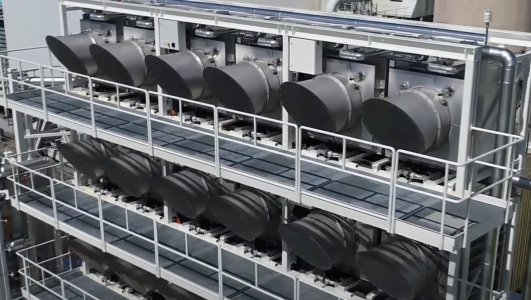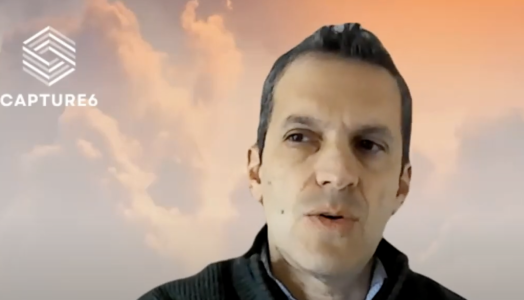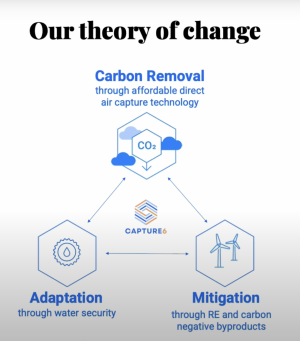A new invention could help lower your water bill and clean the air at the same time
By
Veronica E.
- Replies 0
Water bills have gone up, droughts feel more common, and headlines about climate change are hard to ignore.
But what if there were a way to tackle both the water crisis and climate change—while also cutting costs for your community?
That’s the goal of Capture6, a startup out of Berkeley, California, that's turning heads for its unique and practical solution: cleaning wastewater and removing carbon from the air using one process.
It may sound futuristic, but their technology is already being tested in real-world settings—and the results are promising.
Let’s take a closer look at how it works, why it matters, and what it could mean for everyday Americans like you.

Why this matters now
Water treatment has never been cheap.
It uses a lot of energy and leaves behind brine—a salty byproduct that’s costly to dispose of.
But Capture6 says its process not only removes the need for expensive brine disposal, it also generates clean water and reduces greenhouse gases.
“That combination of water treatment, brine management, and carbon capture all at once is part of what makes us unique, what makes our process innovative,” said Capture6 CEO Ethan Cohen-Cole.
“We are able to do so at reduced energy costs.”
Also read: Why are 50,000 seniors in this state being told to stay indoors today? Here’s what you need to know.
How the process works
Once solids are removed from treated water, what’s left is called brine—essentially salty wastewater.
Typically, facilities must pay a hefty price to dispose of it.
Capture6 instead:
That lye, according to Cohen-Cole, has a powerful side effect: “If you expose it to the air, it will bond with CO₂ and strip it from the air.”
In other words, it captures carbon from the atmosphere.
“We have processed the waste salt, we’ve returned fresh water to our partner, and we’ve captured CO₂ from the air,” he said.
Also read: Breathe cleaner air while you sleep with these 6 magical indoor home additions
Pilot testing in drought-stricken California
The company’s technology is being piloted at the Palmdale Water District, located just north of Los Angeles—an area that knows all too well the impacts of water scarcity.
Scott Rogers, the assistant general manager there, is hopeful.
“It will save us 10% on that capital cost, as well as saving us 20 to 40% in operational costs,” he said.
“We’re recovering anywhere from 94% to 98% water out of water that would just normally be wasted.”
This kind of recovery could significantly improve water access in dry regions while cutting utility costs.
Also read: Fresh scents, hidden dangers: What experts say about indoor air pollution
A broader vision: Circular economy and clean air
Capture6’s goal isn’t just saving water.
Their technology supports a "circular economy"—a system where water is reused, waste is repurposed, and pollution is reduced.
Best of all, the entire process can be powered by renewable energy, meaning it could offer net-negative carbon results.
That’s not just good for the planet—it could also be profitable.
“We’re able to generate added revenue by selling carbon credits,” said Cohen-Cole.

Also read: This appliance is dirtier than your toilet! Can you guess which one it is?
Supported even amid federal cuts
While federal funding for climate technology has been scaled back in recent years—including $3.7 billion in cancellations—Capture6 has still received support from the US Department of Energy, California state sources, and private backers.
To date, the startup has raised $27.5 million from investors including Hyundai Motors, Energy Capital Ventures, Tetrad Corporation, Elemental Impact, and Triple Impact Capital.

What this could mean for you
Though still in its early stages, if Capture6’s system expands successfully, the potential ripple effects include:
And because it can be adapted globally, places like Western Australia and South Korea are already exploring it.
Read next: Protect yourself on your next trip: What you need to know about carbon monoxide detectors

What do you think about this kind of innovation? Have you noticed your utility bills creeping up—or experienced water restrictions? Let us know your thoughts below. It’s these kinds of conversations that shape the future of our communities—and every drop (and word) counts!
But what if there were a way to tackle both the water crisis and climate change—while also cutting costs for your community?
That’s the goal of Capture6, a startup out of Berkeley, California, that's turning heads for its unique and practical solution: cleaning wastewater and removing carbon from the air using one process.
It may sound futuristic, but their technology is already being tested in real-world settings—and the results are promising.
Let’s take a closer look at how it works, why it matters, and what it could mean for everyday Americans like you.

Carbon removal technology plays a vital role in protecting the environment and addressing climate change. Image Source: YouTube / CNBC.
Why this matters now
Water treatment has never been cheap.
It uses a lot of energy and leaves behind brine—a salty byproduct that’s costly to dispose of.
But Capture6 says its process not only removes the need for expensive brine disposal, it also generates clean water and reduces greenhouse gases.
“That combination of water treatment, brine management, and carbon capture all at once is part of what makes us unique, what makes our process innovative,” said Capture6 CEO Ethan Cohen-Cole.
“We are able to do so at reduced energy costs.”
Also read: Why are 50,000 seniors in this state being told to stay indoors today? Here’s what you need to know.
How the process works
Once solids are removed from treated water, what’s left is called brine—essentially salty wastewater.
Typically, facilities must pay a hefty price to dispose of it.
Capture6 instead:
- Extracts the remaining fresh water from the brine
- Separates the salt into sodium and chlorine
- Converts the sodium into lye
That lye, according to Cohen-Cole, has a powerful side effect: “If you expose it to the air, it will bond with CO₂ and strip it from the air.”
In other words, it captures carbon from the atmosphere.
“We have processed the waste salt, we’ve returned fresh water to our partner, and we’ve captured CO₂ from the air,” he said.
Also read: Breathe cleaner air while you sleep with these 6 magical indoor home additions
Pilot testing in drought-stricken California
The company’s technology is being piloted at the Palmdale Water District, located just north of Los Angeles—an area that knows all too well the impacts of water scarcity.
Scott Rogers, the assistant general manager there, is hopeful.
“It will save us 10% on that capital cost, as well as saving us 20 to 40% in operational costs,” he said.
“We’re recovering anywhere from 94% to 98% water out of water that would just normally be wasted.”
This kind of recovery could significantly improve water access in dry regions while cutting utility costs.
Also read: Fresh scents, hidden dangers: What experts say about indoor air pollution
A broader vision: Circular economy and clean air
Capture6’s goal isn’t just saving water.
Their technology supports a "circular economy"—a system where water is reused, waste is repurposed, and pollution is reduced.
Best of all, the entire process can be powered by renewable energy, meaning it could offer net-negative carbon results.
That’s not just good for the planet—it could also be profitable.
“We’re able to generate added revenue by selling carbon credits,” said Cohen-Cole.

Ethan Cohen-Cole, co-founder and CEO of Capture6, leads efforts to develop sustainable solutions for water reuse and carbon removal. Image Source: YouTube / Scott Amyx.
Also read: This appliance is dirtier than your toilet! Can you guess which one it is?
Supported even amid federal cuts
While federal funding for climate technology has been scaled back in recent years—including $3.7 billion in cancellations—Capture6 has still received support from the US Department of Energy, California state sources, and private backers.
To date, the startup has raised $27.5 million from investors including Hyundai Motors, Energy Capital Ventures, Tetrad Corporation, Elemental Impact, and Triple Impact Capital.

Capture6’s theory of change outlines how innovative water reuse and carbon removal technologies can drive environmental and economic impact. Image Source: YouTube / Isle Global.
What this could mean for you
Though still in its early stages, if Capture6’s system expands successfully, the potential ripple effects include:
- More affordable water for drought-prone communities
- Cleaner air through captured CO₂
- Reduced reliance on expensive water disposal
- New job opportunities in green technology
And because it can be adapted globally, places like Western Australia and South Korea are already exploring it.
Read next: Protect yourself on your next trip: What you need to know about carbon monoxide detectors
Key Takeaways
- Capture6, a Berkeley startup, has created technology that repurposes brine waste to generate clean water and remove CO₂ from the air.
- CEO Ethan Cohen-Cole emphasizes the process combines water treatment, waste management, and carbon capture at reduced energy costs.
- The company’s pilot in Palmdale, California, reports up to 98% water recovery and 20–40% savings on operational costs.
- Capture6 has raised $27.5 million and received support from Hyundai Motors, Energy Capital Ventures, and the U.S. Department of Energy; the process can be powered by renewables and generate carbon credits.
What do you think about this kind of innovation? Have you noticed your utility bills creeping up—or experienced water restrictions? Let us know your thoughts below. It’s these kinds of conversations that shape the future of our communities—and every drop (and word) counts!






